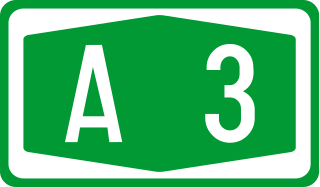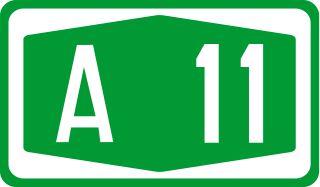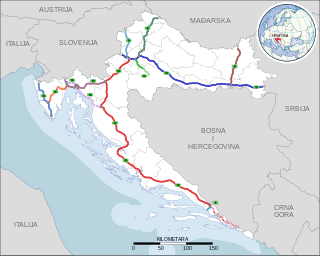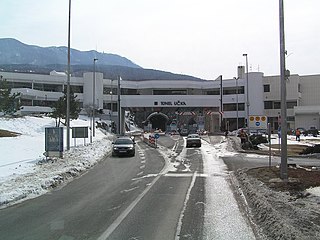
The Istrian Y is a highway network in the Croatian highway network & TEN-T network, maintained by BINA Istra. It consists of 2 sections arranged in a shape similar to the alphabetical letter 'Y', located in the Istria County:

The A1 motorway is the longest motorway in Croatia, spanning 476.3 kilometers (296.0 mi). As it connects the nation's capital Zagreb to the second largest city Split, the motorway represents a major north–south transportation corridor in Croatia and a significant part of the Adriatic–Ionian motorway. Apart from Zagreb and Split, the A1 motorway runs near a number of major Croatian cities, provides access to several national parks or nature parks, world heritage sites, and numerous resorts, especially along the Adriatic Coast. National significance of the motorway is reflected through its positive economic impact on the cities and towns it connects as well as its importance to tourism in Croatia.

The A3 motorway is a major motorway in Croatia spanning 306.5 kilometres (190.5 mi). The motorway connects Zagreb, the nation's capital, to the Slavonia region and a number of cities along the Sava River. It represents a major east–west transportation corridor in Croatia and a significant part of the Pan-European Corridor X, serving as a transit route between the European Union states and the Balkans. Apart from Zagreb, where the A3 motorway comprises a considerable part of the Zagreb bypass, the motorway runs near a number of significant Croatian cities.

The A2 motorway is a motorway in the Hrvatsko Zagorje region of northern Croatia, connecting Zagreb to the Macelj border crossing and Slovenia. The A2 motorway is part of the European route E59 and the Pan-European Corridor Xa. The motorway spans 59.2 kilometres (36.8 mi) between the Slovenian border and the Jankomir interchange within the Zagreb bypass, providing road connections to a number of cities and towns besides Zagreb, including Krapina, Zabok and Zaprešić. All sections of the motorway, except the northernmost one between the Macelj border crossing and Trakošćan, and the southernmost one near Zagreb, are tolled, using a closed toll collection system.

The A4 motorway is a motorway in Croatia spanning 97.0 kilometres (60.3 mi). It connects the nation's capital, Zagreb, to the city of Varaždin and to Budapest, Hungary via the Goričan border crossing. The motorway represents a major north–south transportation corridor in Croatia and is a part of European routes E65 and E71. The A4 motorway route also follows Pan-European corridor Vb.

The A5 motorway is a motorway in Croatia spanning 83.6 kilometres (51.9 mi). It connects Osijek, the largest city in Slavonia region, to the Croatian motorway network at the Sredanci interchange of the A3 motorway. The A5 represents a significant north–south transportation corridor in Croatia and is a part of the European route E73. The A5 motorway route also follows Pan-European corridor Vc. In addition to Osijek, the A5 motorway also passes near Đakovo and Beli Manastir.

The A6 motorway is a motorway in Croatia spanning 80.2 kilometres (49.8 mi). It connects the nation's capital, Zagreb, via the A1, to the seaport of Rijeka. The motorway forms a major north–south transportation corridor in Croatia and is a part of European route E65 Nagykanizsa–Zagreb–Rijeka–Zadar–Split–Dubrovnik–Podgorica. The A6 motorway route also follows Pan-European corridor Vb.

The A7 motorway is a 42.4-kilometre-long (26.3 mi) motorway in Croatia. It connects the nation's largest port in Rijeka, to the Croatian motorway network, as well as to the Rupa and Pasjak border crossings to Slovenia. The motorway forms part of a longitudinal transportation corridor in Croatia, and it is a part of European route E61 Villach–Ljubljana–Trieste–Rijeka. The A7 motorway route south of Orehovica interchange, where it also intersects Pan-European corridor Vb, is a part of European route E65.

The A8 motorway is a 64.0-kilometre (39.8 mi) toll motorway in Croatia. It connects the A7 motorway near Rijeka with the road network in the Istrian peninsula via the Učka Tunnel. The road terminates at the Kanfanar interchange with the A9 motorway, which with the A8 motorway forms the Istrian Y road system. The motorway's national significance is reflected in its positive economic impact on the cities and towns it connects, as well as its importance to tourism in Croatia. The importance of the motorway for tourism is particularly high during the summer tourist season, when its traffic volume increases by about 65%.

The A9 motorway is a north–south motorway in Croatia, with a length of 78.3 kilometres. Beginning in Pula, the largest city on the Istrian peninsula, it runs north to the Croatian motorway and expressway network at the Kanfanar interchange. Here it meets the A8 motorway, forming the Istrian Y road system. The A9 continues north from here to the Kaštel and Plovanija border crossings into Slovenia. The motorway represents a significant north–south transportation corridor in Croatia and is a part of the European route E751. The motorway's national significance is reflected in the positive economic impact on the cities and towns it connects, as well as its importance to tourism in Croatia. Importance of the motorway for tourism is particularly high during summer tourist seasons, when traffic volume increases by more than 80%.

The A11 motorway is an incomplete motorway in Croatia, 30 kilometres long. It connects the Jakuševec interchange of the Zagreb bypass, to the south of Zagreb, to Velika Gorica and onwards to Sisak, but currently reaches only the Lekenik exit, as of the planned 42-kilometre (26 mi) route, 30 km (19 mi) are completed. The motorway is planned as a north–south transportation corridor for commuter traffic between the cities.

The European route E751, or E751, as defined by the Declaration on the Construction of Main International Traffic Arteries of 1975, and subsequent documents which amended the treaty, is an east–west Class-B branching European road route. Originating in Rijeka, Croatia, where it diverges from European route E61 before passing through the Kanfanar interchange, the route connects Pula, Rovinj, Poreč and Umag in Croatia with Koper in Slovenia. The route provides a high-performance road link in Istria and Slovenian Littoral. Unlike most routes, the E751 centers on the Kanfanar interchange and has three arms, each extending to Rijeka, Pula and Koper. The total length of the route, including all the route arms, is 160 km (99 mi).

Highways in Croatia are the main transport network in Croatia. The Croatian classification includes several classes of highways:

The Učka Tunnel is a toll tunnel on the A8 motorway in Croatia, under the Učka mountain range, as part of the Istrian Y network in Istria owned and operated by BINA Istra.
The D12 is a partially built state road in central Croatia that is intended to connect the Vrbovec 2 interchange with Bjelovar, Virovitica and end at the border crossing Terezino Polje. Its planned length is 86.5 kilometres (53.7 mi).

D425 is a state road in Croatia, connecting the outskirts of Ploče with the A1 motorway connector at the Karamatići toll station. Its main purpose is a connection from the motorway to the Port of Ploče. The road is 9.87 km (6.13 mi) long.
Hrvatske autoceste (HAC) or Croatian Motorways Ltd is a Croatian state-owned limited liability company tasked with management, construction and maintenance of motorways in Croatia pursuant to provisions of the Croatian Public Roads Act enacted by the Croatian Parliament. Tasks of the company are defined by Public Roads Act and its Founding Declaration, and the principal task of the company is management, construction and maintenance of the motorways. In practice, Hrvatske autoceste is responsible for management or development the following motorway sections:

Autocesta Zagreb–Macelj is a Croatian limited liability company founded pursuant to decision of the government of the Republic of Croatia of 27 March 2003 to facilitate construction and subsequent management of a motorway between Zagreb and Macelj border crossing to Slovenia. The company was subsequently granted concession for construction and management of the A2 motorway, and restructured in the process: The Republic of Croatia retained 49% of ownership stake in the company, while 51% ownership stake was attained by Walter Motorway, owned by Walter Bau AG, Strabag and Dywidag. The company was granted the motorway management concession for a period of 28 years.

The Mirna Bridge is located between the Nova Vas and Višnjan interchanges of the A9 motorway in Istria, Croatia, spanning the Mirna River and the wide Mirna River valley. It is 1,378 metres (4,521 ft) long and comprises two traffic lanes. The bridge has been open for traffic since June 2005. The bridge is one of the most significant structures on the motorway. The bridge was designed by Zlatko Šavor.

The D10 expressway is a partially built expressway in the central Croatia northeast from Zagreb extending towards the city of Križevci. It is currently executed as a 35 km (14 mi) long expressway that spans from the A4 motorway Sveta Helena interchange via Vrbovec, to the city of Križevci. The D10 expressway represents the western arm of the so-called Podravina Y, as the eastern arm is planned to be the D12 expressway.


















